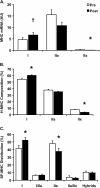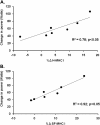Myosin heavy chain plasticity in aging skeletal muscle with aerobic exercise training
- PMID: 21659340
- PMCID: PMC3202903
- DOI: 10.1093/gerona/glr088
Myosin heavy chain plasticity in aging skeletal muscle with aerobic exercise training
Abstract
To assess myosin heavy chain (MHC) plasticity in aging skeletal muscle with aerobic exercise training, MHC composition was measured at the messenger RNA (mRNA) level and protein level in mixed-muscle homogenates and single myofibers. Muscle samples were obtained from eight nonexercising women (70 ± 2 years) before and after 12 weeks of training (20-45 minutes of cycle exercise per session at 60%-80% heart rate reserve, three to four sessions per week). Training elevated MHC I mRNA (p < .10) and protein (p < .05) in mixed-muscle (54% ± 4% to 61% ± 2%) and single myofibers (42% ± 4% to 52% ± 3%). The increase in MHC I protein was positively correlated (p < .05) with improvements in whole muscle power. Training resulted in a general downregulation of MHC IIa and IIx at the mRNA and protein levels. The training-induced increase in MHC I protein and mRNA demonstrates the maintenance of skeletal muscle plasticity with aging. Furthermore, these data suggest that a shift toward an oxidative MHC phenotype may be beneficial for metabolic and functional health in older individuals.
Figures



References
-
- Janssen I, Heymsfield SB, Ross R. Low relative skeletal muscle mass (sarcopenia) in older persons is associated with functional impairment and physical disability. J Am Geriatr Soc. 2002;50(5):889–896. - PubMed
-
- Doherty TJ. Invited review: aging and sarcopenia. J Appl Physiol. 2003;95(4):1717–1727. - PubMed
-
- Lexell J, Henriksson-Larsen K, Winblad B, Sjostrom M. Distribution of different fiber types in human skeletal muscles: effects of aging studied in whole muscle cross sections. Muscle Nerve. 1983;6(8):588–595. - PubMed
-
- Lexell J, Taylor CC, Sjostrom M. What is the cause of the ageing atrophy? Total number, size and proportion of different fiber types studied in whole vastus lateralis muscle from 15- to 83-year-old men. J Neurol Sci. 1988;84(2–3):275–294. - PubMed
Publication types
MeSH terms
Substances
Grants and funding
LinkOut - more resources
Full Text Sources
Medical
Research Materials

